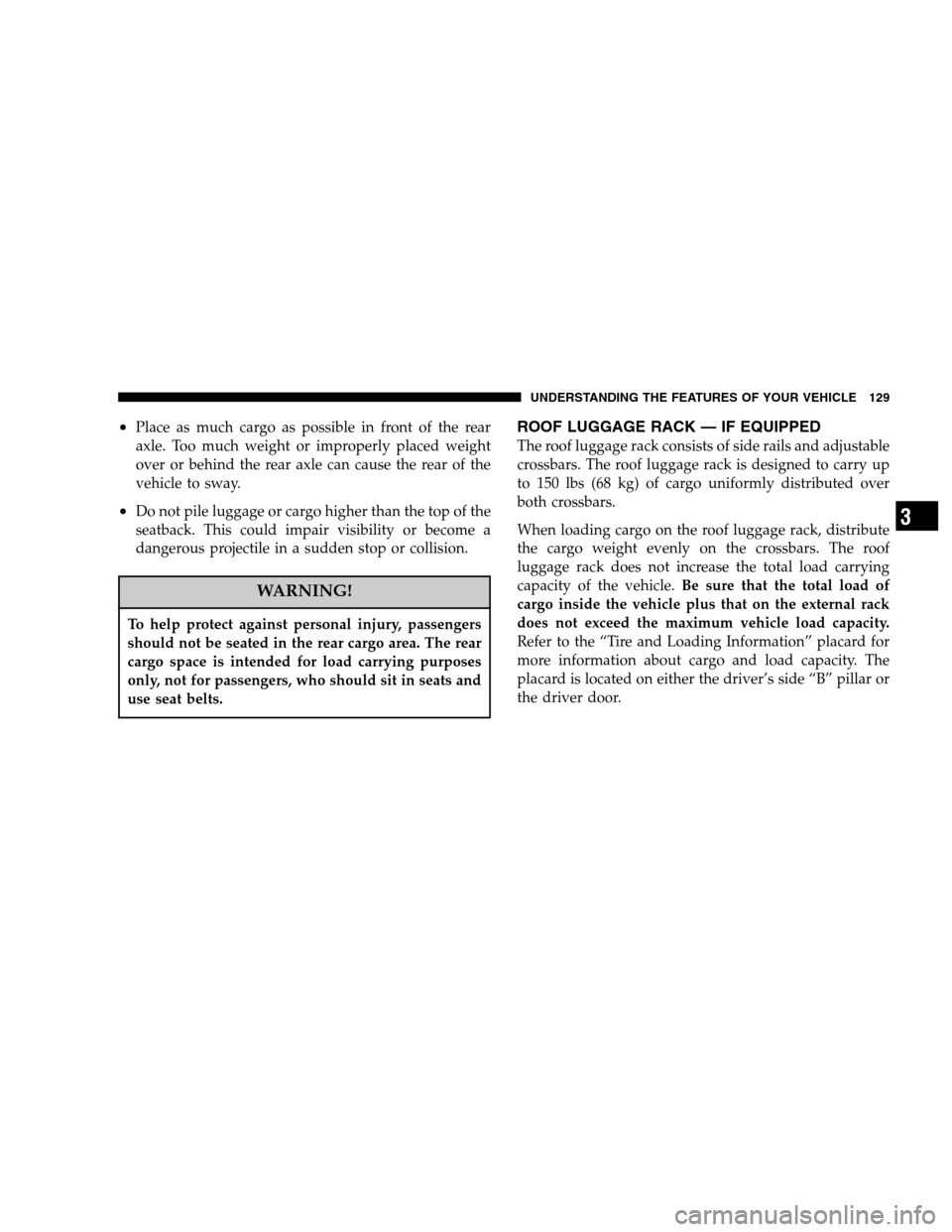DODGE MAGNUM 2007 1.G Owners Manual
Manufacturer: DODGE, Model Year: 2007, Model line: MAGNUM, Model: DODGE MAGNUM 2007 1.GPages: 400, PDF Size: 1.96 MB
Page 121 of 400

CUP HOLDERS
Front Seat Cup Holders
The cup holders are located in the forward edge of the
center console.
Rear Seat Cup Holders
The rear seat cup holders are located in the center armrest
between the rear seats. The cup holders are positioned
forward in the armrest and side-by-side to provide
convenient access to beverage cans or bottles while
maintaining a resting place for the rear occupants’ el-
bows.
Front Seat Cup Holders
Rear Seat Cup Holders
UNDERSTANDING THE FEATURES OF YOUR VEHICLE 121
3
Page 122 of 400

STORAGE
Console Features
The center console contains a large storage bin. The
storage bin contains a four-slot coin holder (designed to
hold various size coins) and a rubber mat at the bottom of
the bin for noise control. The bin is large enough to hold
a portable AC/DC converter to power laptops, games, or
other electrical equipment. Two slots at the top right side
of the bin provide clearance for power cords to pass
conveniently out of the bin with the lid closed. This
feature is ideal for games, laptops, cell phones, or other
electrical equipment. The console’s front-opening lid
allows for easy access to the storage bin for the both the
driver and the front passenger. The inside portion of the
arm rest lid contains a penholder, a tissue holder, and a
tire gauge holder.
In addition to the internal storage, the console contains
two shift bezel cubby bins with rubber mats for holding
small items. For vehicles not equipped with navigation
radio, the console also contains an extra storage bin
located below the climate control, which holds up to four
CD jewel cases.
Cargo Management System — If Equipped
The cargo area has an upper and lower load floor.
Additional innovative features in the cargo area are the
two molded-in bins in the quarter trim panels. Each bin
will hold a gallon of milk and a 2-liter bottle of pop.
A cargo management system that stores on the lower
load floor below the bi-level cargo floor is optional. It
includes the following equipment:
•Waterproof cargo floor liner.
•Folding cargo management container with net separa-
tors.
The bi-level cargo floor includes a removable, tri-fold
load-bearing upper level. Two folds in the panel allow it
to be partially or fully folded for storage flexibility.
Shallow items can be stored underneath the upper load
floor.
The lower load floor is hinged to provide access to the
spare tire (if equipped), battery, and rear electrical power
distribution center.
122 UNDERSTANDING THE FEATURES OF YOUR VEHICLE
Page 123 of 400

The 60/40 split-folding rear seat provides cargo-carrying
versatility. The seatbacks fold down easily by pulling
nylon tabs between the seatbacks and the bolsters. When
the seats are folded down, they provide a continuous,
nearly flat extension of the removable tri-fold load floor.
Tri-Fold Upper Load Floor
The removable tri-fold upper load floor has two different
surfaces for increased utility. One side is carpeted for a
plush appearance and the other side is covered with
vinyl for easy cleaning. The panel, sandwiched between
the carpet and the washable-vinyl, is constructed from a
strong lightweight material that gives the floor its load-
bearing strength.
You can place the load floor in a partially folded position,
a fully folded position, or a flat position. You can also
remove it from the vehicle. Folding and/or removing the
load floor will add four inches to the height of the cargo
area for increased utility. Use the handle to adjust the
position of the load floor. The load floor positions are
shown in the following illustrations.
Load Floor Handle
UNDERSTANDING THE FEATURES OF YOUR VEHICLE 123
3
Page 124 of 400

Load Floor Partially FoldedLoad Floor Fully Folded
124 UNDERSTANDING THE FEATURES OF YOUR VEHICLE
Page 125 of 400

Rollaway Tonneau Cover — If Equipped
The removable rollaway tonneau cover mounts in the
cargo area behind the top of the rear seats.
The tonneau cover, when extended, covers the cargo area
to keep items out of sight. Notches in the trim panels near
the liftgate opening secure the extended tonneau cover in
place.The tonneau cover rolls away neatly inside its housing
when not in use. You can also remove the tonneau cover
from the vehicle to make more room in the cargo area.
UNDERSTANDING THE FEATURES OF YOUR VEHICLE 125
3
Page 126 of 400

To install the tonneau cover, position it in the vehicle so
that the flat side of the housing faces upward. Then,
insert either the left or the right spring-loaded post
(located on the ends of the tonneau cover housing) into
the left or the right front attachment point shown.Then, insert the spring-loaded post on the opposite end
of the tonneau cover housing into the remaining front
attachment point.
Next, grab the tonneau cover handle and pull the cover
toward you. As the cover nears the liftgate opening,
guide the rear attachment posts (on both ends of the
cover) into the notches in the trim panels. Then, lower the
cover to position the posts into the bottom of the notches
and release the handle.
Front Attachment Points
Rear Attachment Points
126 UNDERSTANDING THE FEATURES OF YOUR VEHICLE
Page 127 of 400

Waterproof Liner
The optional waterproof liner can be placed over the
lower load floor.
Cargo Organizer
The optional cargo organizer can also be placed into the
lower load floor. Lift the handle and pull to open the
cargo organizer.
Waterproof Liner
Cargo Organizer Handle
UNDERSTANDING THE FEATURES OF YOUR VEHICLE 127
3
Page 128 of 400

Cargo Tie-Down Hooks
The tie-downs located on cargo area floor and on the rear
trim panels should be used to safely secure loads when
vehicle is moving.
WARNING!
•Cargo tie-down hooks are not safe anchors for a
child seat tether strap. In a sudden stop or colli-
sion, a hook could pull loose and allow the child
seat to come loose. A child could be badly injured.
Use only the anchors provided for child seat
tethers.
•The weight and position of cargo and passengers
can change the vehicle center of gravity and
vehicle handling. To avoid loss of control result-
ing in personal injury, follow these guidelines for
loading your vehicle:
•Always place cargo evenly on the cargo floor. Put
heavier objects as low and as far forward as possible.
128 UNDERSTANDING THE FEATURES OF YOUR VEHICLE
Page 129 of 400

•Place as much cargo as possible in front of the rear
axle. Too much weight or improperly placed weight
over or behind the rear axle can cause the rear of the
vehicle to sway.
•Do not pile luggage or cargo higher than the top of the
seatback. This could impair visibility or become a
dangerous projectile in a sudden stop or collision.
WARNING!
To help protect against personal injury, passengers
should not be seated in the rear cargo area. The rear
cargo space is intended for load carrying purposes
only, not for passengers, who should sit in seats and
use seat belts.
ROOF LUGGAGE RACK — IF EQUIPPED
The roof luggage rack consists of side rails and adjustable
crossbars. The roof luggage rack is designed to carry up
to 150 lbs (68 kg) of cargo uniformly distributed over
both crossbars.
When loading cargo on the roof luggage rack, distribute
the cargo weight evenly on the crossbars. The roof
luggage rack does not increase the total load carrying
capacity of the vehicle.Be sure that the total load of
cargo inside the vehicle plus that on the external rack
does not exceed the maximum vehicle load capacity.
Refer to the “Tire and Loading Information” placard for
more information about cargo and load capacity. The
placard is located on either the driver’s side “B” pillar or
the driver door.
UNDERSTANDING THE FEATURES OF YOUR VEHICLE 129
3
Page 130 of 400

To adjust, remove, or install the crossbars, proceed as
follows:
1. Flip the lever on the end of the crossbar upward.
2. Turn the lever counter clockwise to loosen the lower
clamp. When the lower clamp is loose, turn it until the
round side of the clamp completely faces away from the
side rail.3. Repeat Steps 1 and 2 on the opposite clamp on the
other side of the crossbar.
4. Pick up the crossbar and move it to the desired
location. Do not place the crossbar directly over the
sunroof glass (if equipped).
5. Turn the lower clamp until the round side of the clamp
completely faces the side rail.
6. Turn the lever clockwise to tighten the lower clamp to
the side rail. When tight, flip the lever downward.
7. Repeat Steps 5 and 6 on the opposite clamp on the
other side of the crossbar.
8. Attempt to move the crossbar to ensure that it is
locked in position.
NOTE:To reduce the amount of wind noise when the
crossbars are not in use, remove both crossbars from the
side rails and place them inside the vehicle.
Roof Luggage Rack
130 UNDERSTANDING THE FEATURES OF YOUR VEHICLE